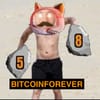
Hashcash was invented as a way to solve the sybil attack problem, where false online identities or user accounts run rampant and attempt to execute a Denial-of-Service (DoS) attack on platforms and networks. Hashcash was applied to Bitcoin in order to keep all miners in the network honest.
The “hashcash CPU cost-function” encapsulates a Proof-of-Work (PoW) in order to legitimize a user’s participation. By making it very costly to spam or take over a network, like Bitcoin, the hashcash mechanism incentivizes participants to support the network rather than attack it.
Adam Back came up with the idea for hashcash in 1997, and describes how it works in his 2002 article, “Hashcash - A Denial of Service Counter-Measure.” Cypherpunk and British cryptographer Adam Back co-founded Blockstream in 2014, and currently serves as its CEO. Back was one of the first two recipients of an email from Satoshi Nakamoto and has also been suspected to be Nakamoto himself by many news outlets with feeble evidence.
On March 28th, 1997, around 2,000 subscribers to the Cypherpunks mailing list received an email from Back that contained a description and early implementation of what he called a “partial hash collision based postage method,” which is essentially a clever cryptographic version of a stamp for emails.
Back wrote that “The idea of using partial hashes is that they can be made arbitrarily expensive to compute… and yet can be verified instantly,” which deters bad actors from spamming a platform, creating fake accounts, sending excessive messages, or performing other nefarious activities.
Back's proposal did not immediately spark much interest within the Cypherpunks email group, only one reader replied, but hashcash would heavily influence the development of Bitcoin.
Back clarifies that he did not invent PoW but rather “re-invented” or repurposed its use case by suggesting to implement it for mining coins.
“This is why the concept of hashcash and mining was attractive — as some people could mine it to create coins, and others could buy and sell them in the decentralized secondary market because there was no centralized database nor bank partnership needed,” says Back.
Earlier projects also realized the same need for an incentive mechanism to keep network participants as honest actors but were unsuccessful at the time. Back highlights that “There were also gaps in B-Money and Bit-Gold, so they were not fully complete projects or had players and human markets fulfilling functions that Bitcoin is able to automate within the protocol.”
20 years after hashcash, Bitcoin builders still draw inspiration from Back’s work. Strike CEO Jack Mallers was inspired by Back’s hashcash and proceeded to develop a solution for email spam with Bitcoin’s Lightning Network.
It now costs $1 to send a message to Mallers’ publicly available Reacher email in order to counter unsolicited emails.
It is hard to say what the next 20 years will look like for Bitcoin but we can thank Adam Back and Satoshi Nakamoto for their hard work in giving individuals a chance to opt into a more honest system.

